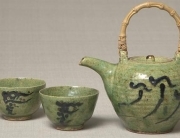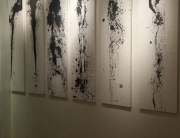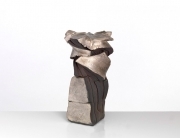The Ceramics and Ukiyo-e Masterpieces from the Hagi Uragami Museum exhibition at the Nezu Museum in Tokyo ran from June 1-July 15, 2013. The exhibit was extremely unique since it was the first time that the Nezu Museum showcased traditional Japanese ukiyo-e prints. Some of the prints, like Mount Fuji at Dawn by Katsushika Hokusai, are quite famous words of art.
Even casual observers would recognize Actor Ichikawa Komazo III at Shiga Daishichi or Kitagawa Utamaro’s Naniwa-ya Okita. These pieces are famous even in western culture, which probably attracted countless individuals who appreciate fine art. The Hagi Uragami Museum features a collection of art originally purchased by Uragami Toshiro.

This jar features a swelling torso and a rather unique combination of glazing colors reminiscent of Middle Eastern carpets. Photo credit: Nezu Museum
As well as these prints, the museum boasts a collection of around 2,500 pieces of ceramic art. These ceramics are primarily from Korea and China. A group of 130 Chinese and Korean ceramic vessels were chosen from the collection to visit the Nezu Museum.
Aditionally 62 ukiyo-e prints were selected to accompany these vessels. The prints range from the early period through the golden age of ukiyo-e art. Those with at least some formal training in art appreciation will recognize the concept of bijin-ga. That term usually refers to the delicate images of beautiful women that seem to pervade the entire ukiyo-e genre.
Ceramics displayed at the exhibition were truly eclectic. Many of them had some connection to a foreign power. For instance, a certain square flask notable for having two handles was not originally made in Japan. The piece, which was made sometime during the 18th or 19th century, was initially made in Choson dynasty Korea. The scenes on this piece are particularly interesting.
The front of the flask shows an image of a rabbit who is pounding rice cakes. Chinese folk practices have long suggested that there is a rabbit who lives on the moon and does just that. This explains why rice cakes are often associated with lunar festivals, though it also gives the piece a rather exotic feel.

This square flask from the Choson dynasty tells a story through the image of a rabbit making rice cakes on the obverse side. Photo credit: Nezu Museum
Speaking of exotic, a Tang dynasty Chinese jar from the 8th century really stood out at the Nezu museum exhibition. The piece has a very intricate design that seems to be inspired by Middle Eastern carpet weaving. Such carpets would have been available to Chinese buyers as a result of caravans that undertook perilous journeys over the Silk Road. This ceramic design would certainly look exotic even to Japanese collectors.
The Choson dynasty was certainly a halcyon period for artists working with porcelain. The exhibition also featured a 19th century jar that prominently displays a design with a squirrel on a grape vine. The choice of setting is rather demure, which gives the piece a certain serene quality that is probably missing in a majority of busier pieces.
Those who missed the exhibition might want to plan a trip to the Hagi Uragami Museum. When it was founded in 1996, it created quite a stir. Those who are currently in Yamaguchi Prefecture certainly shouldn’t miss out on this rare opportunity to enjoy such exquisite works of art.




